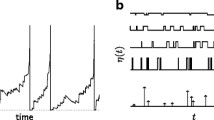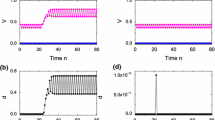Abstract
Many physical and biological phenomena involve accumulation and discharge processes that can occur on significantly different time scales. Models of these processes have contributed to understand excitability self-sustained oscillations and synchronization in arrays of oscillators. Integrate-and-fire (I+F) models are popular minimal fill-and-flush mathematical models. They are used in neuroscience to study spiking and phase locking in single neuron membranes, large scale neural networks, and in a variety of applications in physics and electrical engineering. We show here how the classical first-order I+F model fits into the theory of nonlinear oscillators of van der Pol type by demonstrating that a particular second-order oscillator having small parameters converges in a singular perturbation limit to the I+F model. In this sense, our study provides a novel unfolding of such models and it identifies a constructible electronic circuit that is closely related to I+F.
Similar content being viewed by others
References
Andronov AA, Vitt AA, Khaikin SE (1987) Theory of oscillators. Dover Publications, New York (Original published in 1937 in Russian, in English in 1966)
Carrillo H, Ongay F (2001) On the firing maps of a general class of forced integrate and fire systems. J Math Biosci 172: 33–53
Carrillo H, Mendoza M, Ongay F (2004) Integrate-and-fire neurons and circle maps. WSEAS Trans Biol Biomed 1(2): 287–293
Cole JD, Kevorkian JK (1981) Perturbation methods in applied mathematics. Springer, Berlin
Eckhaus W (1979) Asymptotic analysis of singular perturbation problems. Elsevier/North-Holland, New York
Fitzhugh R (1961) Impulses and physiological states in theoretical models of nerve membranes. Biophys J 1: 445–466
Flaherty JE, Hoppensteadt FC (1978) Frequency entrainment of a forced van der Pol oscillator. Stud Appl Math 59: 5–15
Hoppensteadt F (1971) Properties of solutions of ordinary differential equations with small parameters. Comm Pure Appl Math XXIV: 807–840
Hoppensteadt F (2000) Analysis and simulation of chaotic systems. Springer, New York
Hoppensteadt F (1969) On systems of ordinary differential equations with several small parameters multiplying the derivatives. J Differ Equ 5: 106–116
Hoppensteadt FC, Izhikevich EM (1997) Weakly connected neural networks. Springer, New York
Hoppensteadt FC (1997) Introduction to the mathematics of neurons: modeling in the frequency domain, 2nd edn. Cambridge University Press, Cambridge
Izhikevich EM http://vesicle.nsi.edu/users/izhikevich/human_brain_simulation/Blue_Brain.htm
Izhikevich EM (2007) Dynamical systems in neuroscience: the geometry of excitability and bursting. The MIT Press, Cambridge
Izhikevich E (2003) Simple model of spiking neurons. IEEE Trans Neural Netw 14(6):1569ff. Scholarpedia, http://www.scholarpedia.org
Keener JP, Hoppensteadt FC, Rinzel J (1981) Integrate and fire models of nerve membrane response to oscillatory input. SIAM J Appl Math 41: 503–517
Kennedy M, Chua L (1986) Van der Pol and Chaos. IEEE Trans Circuits Syst 33(l): 974–980
Knight BW (1972) Dynamics of encoding in a population of neurons. J Gen Physiol 59: 734–766
Landauer R (1977) Poor man’s chaos. IBM Technical Report
Levi M (1981) Qualitative analysis of the periodically forced relaxation oscillations. Memoirs, 32 (244), American Mathematical Society, Providence, RI
Levi M (1990) A period adding phenomenon. SIAM J Appl Math 50(4): 943–955
Nagumo J, Arimoto S, Yoshizawa S (1962) An active pulse transmission line simulating nerve axon. Proc IRE 50: 2061–2070
Peskin CS, Neuroscience lecture notes, http://www.math.nyu.edu/faculty/peskin/neuronotes
Petrani ML, Karakotsou CH, Kyprianidis IM, Anagnostopoulos AN (1994) Characterization of the attractor governing the neon bulb RC relaxation oscillator. Phys Rev E 49(6): 5863–5866
Stoker JJ (1951) Nonlinear vibrations. Wiley-Interscience, New York
van der Pol B, van der Mark J (1927) Frequency demultiplication. Nature, 120:363–364. (See also van der Pol B (1960) Selected scientific papers (Bremmer H, Bouwkamp CJ, eds) North Holland Publ., Amsterdam)
Winfree AS (2000) The geometry of biological time, 2nd edn. Springer, New York
Yang T, Kiehl R, Chua L (2001) Tunneling phase logic cellular nonlinear networks. Int J Bifurcation Chaos Appl Sci 11: 2895–2912
Author information
Authors and Affiliations
Corresponding author
Rights and permissions
About this article
Cite this article
Carrillo, H., Hoppensteadt, F. Unfolding an electronic integrate-and-fire circuit. Biol Cybern 102, 1–8 (2010). https://doi.org/10.1007/s00422-009-0358-x
Received:
Accepted:
Published:
Issue Date:
DOI: https://doi.org/10.1007/s00422-009-0358-x




